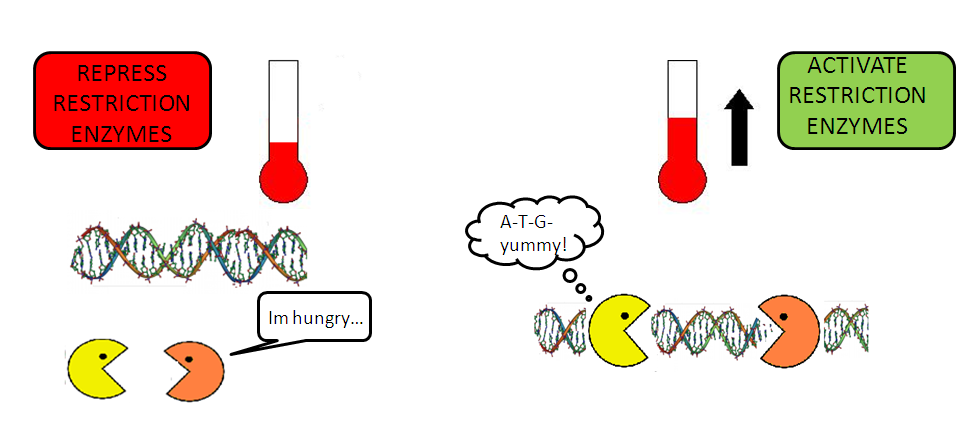Team:Imperial College London/Drylab/Genome deletion
From 2009.igem.org
(Difference between revisions)
(→Background) |
(→Model for cell death) |
||
| Line 23: | Line 23: | ||
<!--Dam methylase works by transferring a methyl group to the N6 position of the adenine residues in the sequence GATC[[http://www.neb.com/nebecomm/tech_reference/restriction_enzymes/dam_dcm_cpg_methylation.asp 3]]. As a result, restriction enzymes cannot recognise their intended cleavage site. This means that DNA will not be cleaved in the presence of Dam methylase and E. coli cells will not die. As it competes with restriction enzymes for DNA, at low restriction enzymes concentrations, Dam methylase will be able to methylate DNA and protect it. However, as the concentration of restriction enzymes increase at higher temperatures, the amount of constitutively produced Dam methylase will no longer be sufficient to protect against cell death, and cell killing occurs.--> | <!--Dam methylase works by transferring a methyl group to the N6 position of the adenine residues in the sequence GATC[[http://www.neb.com/nebecomm/tech_reference/restriction_enzymes/dam_dcm_cpg_methylation.asp 3]]. As a result, restriction enzymes cannot recognise their intended cleavage site. This means that DNA will not be cleaved in the presence of Dam methylase and E. coli cells will not die. As it competes with restriction enzymes for DNA, at low restriction enzymes concentrations, Dam methylase will be able to methylate DNA and protect it. However, as the concentration of restriction enzymes increase at higher temperatures, the amount of constitutively produced Dam methylase will no longer be sufficient to protect against cell death, and cell killing occurs.--> | ||
| - | |||
| - | |||
Based on the [[Team:Imperial_College_London/M3/Genetic |genetic circuit]], we know that | Based on the [[Team:Imperial_College_London/M3/Genetic |genetic circuit]], we know that | ||
| Line 32: | Line 30: | ||
*When there is an increase in temperature (from 28°C to 42°C <cite>[http://www.ncbi.nlm.nih.gov/pubmed/15652426?ordinalpos=13&itool=EntrezSystem2.PEntrez.Pubmed.Pubmed_ResultsPanel.Pubmed_DefaultReportPanel.Pubmed_RVDocSum [1]]</cite><cite>[http://www.ncbi.nlm.nih.gov/pubmed/10235623 [2]]</cite>), there will be a de-repression of lambda cI promoter, causing restriction enzymes DpnII and TaqI to be produced. | *When there is an increase in temperature (from 28°C to 42°C <cite>[http://www.ncbi.nlm.nih.gov/pubmed/15652426?ordinalpos=13&itool=EntrezSystem2.PEntrez.Pubmed.Pubmed_ResultsPanel.Pubmed_DefaultReportPanel.Pubmed_RVDocSum [1]]</cite><cite>[http://www.ncbi.nlm.nih.gov/pubmed/10235623 [2]]</cite>), there will be a de-repression of lambda cI promoter, causing restriction enzymes DpnII and TaqI to be produced. | ||
| - | + | ===Our goals=== | |
| - | ==Our goals== | + | [[Image:II09_hitemp_lotemp.jpg|right|300px]] |
| - | + | ||
We aim to: | We aim to: | ||
Revision as of 14:22, 18 September 2009

Genome Deletion
Based on the genetic circuit, we know that
- The lambda cI promoter is repressed by the protein cI that is produced constitutively under the strong promoter J23114.
- At 28°C, functional protein cI will bind to the lambda cI promoter to repress it. Restriction enzymes DpnII and TaqI will not be produced.
- When there is an increase in temperature (from 28°C to 42°C [http://www.ncbi.nlm.nih.gov/pubmed/15652426?ordinalpos=13&itool=EntrezSystem2.PEntrez.Pubmed.Pubmed_ResultsPanel.Pubmed_DefaultReportPanel.Pubmed_RVDocSum [1]][http://www.ncbi.nlm.nih.gov/pubmed/10235623 [2]]), there will be a de-repression of lambda cI promoter, causing restriction enzymes DpnII and TaqI to be produced.
Our goals
We aim to:
- Explore how temperature correlates to restriction enzyme concentration, and see how it affects the population of live cells, so as to characterise the effects of temperature on cell death.
- Develop a model of the number of dead cells as this correlates to our live and dead cells assay. (hyperlink to assay). From this, we can monitor the rate of killing and perform data analysis to obtain the necessary parameters.
In summary, our model will allow us to characterise the effects of temperature on the parallel production of restriction enzymes DpnII and TaqI, that are required to kill E. coli. We can also characterise the extent Dam methylase can protect E. coli against cell death. (not yet done)
Click HERE for more details of the model
Genome deletion
Killing induced by thermoinduction
 "
"




